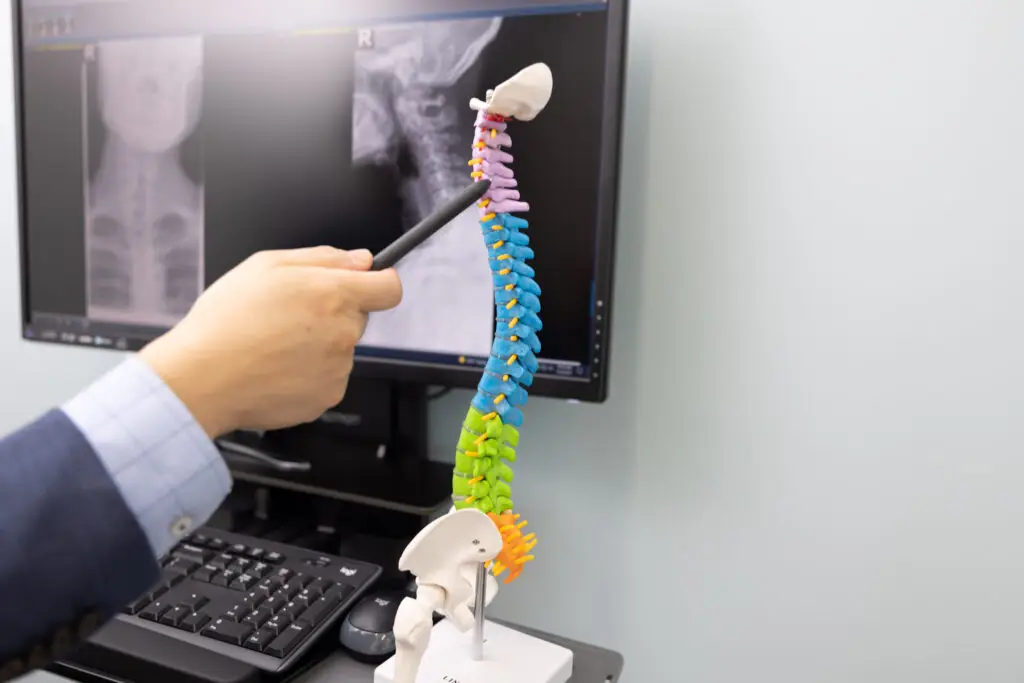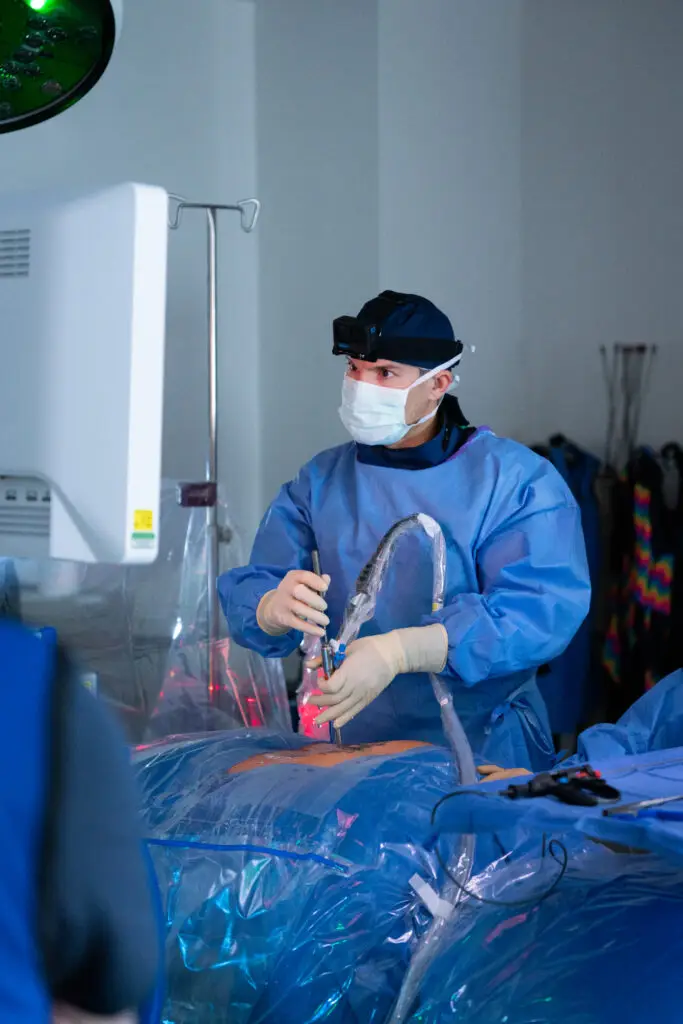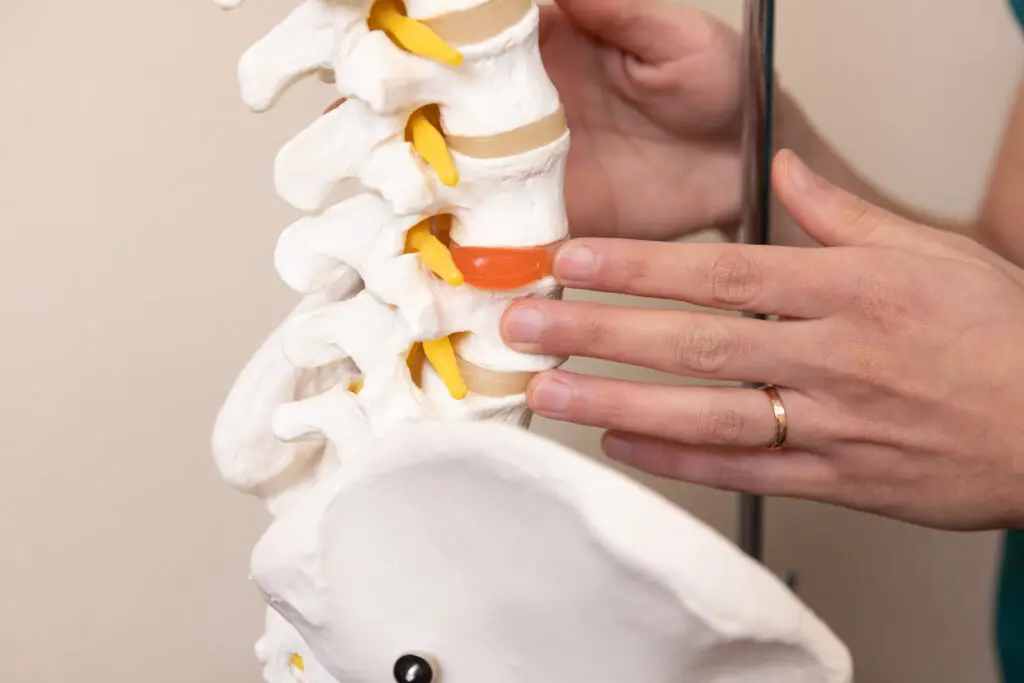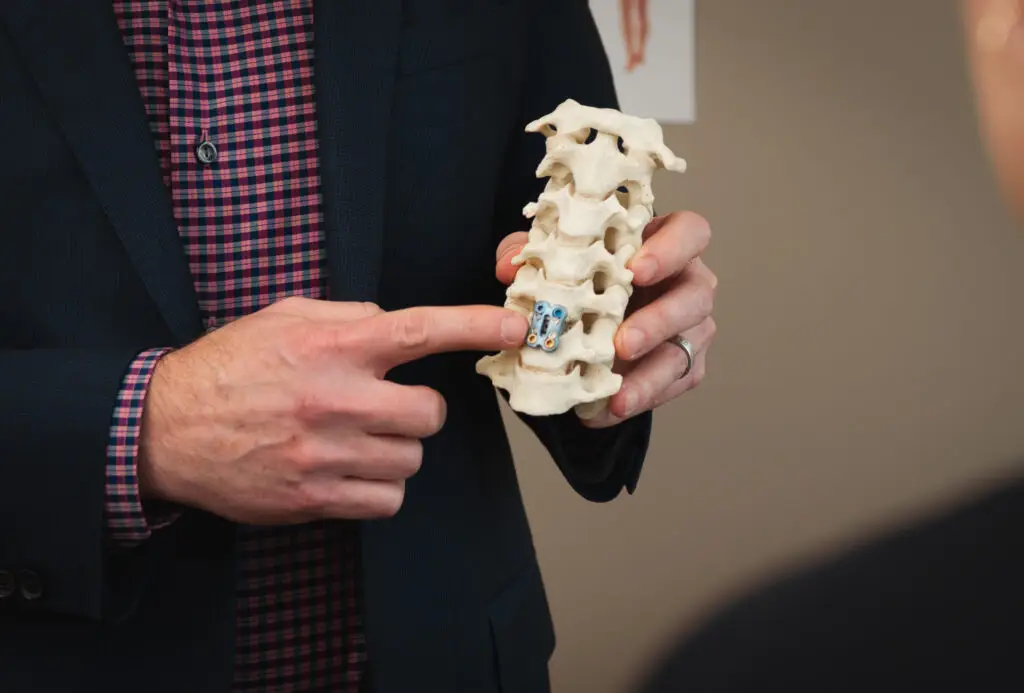Minimally Invasive Spine Surgery: Less Is More
how we can help
Minimally Invasive Spinal Surgery Overview
Since ancient times, physicians have recognized the value of observing injured or diseased internal organs. The challenge with this diagnostic and treatment strategy was the potential for patient complications associated with the incisions and muscle damage caused by this surgical procedure. Spine surgery was like every other procedure in that it was “open surgery.” This meant the area being operated on was “opened” with a long incision to allow the surgeon to view and access the anatomy around the spine.
In the 1970s, this changed. Technological advances allowed back and neck conditions to be treated differently, avoiding the large incisions and the potential for muscle damage. Minimally invasive spinal surgical (MISS) techniques were introduced, and patient outcomes dramatically improved. Since that time, Texas Back Institute has been among the world leaders in minimally invasive spine surgery.
According to this well-respected spine surgery association, “minimally invasive spine surgery (MISS) accomplishes the same goal as open surgery, but through smaller incisions.” It adds, “with long incisions, there is more associated muscle damage.”
“Because the incision is smaller with minimally invasive spine surgery, it avoids significant damage to the muscles surrounding the spine. Typically, this results in less pain after surgery and a faster recovery. However, because the spine surgeon is operating through a smaller opening, the learning curve for minimally invasive spine surgery is longer, so it is technically more challenging for the physician.”
The spine specialists at Texas Back Institute only recommend surgery as the last resort, and it is prescribed after strict criteria have been met. Minimally invasive spine surgery has the same criteria as open surgery.
- Spine surgery is recommended only when a period of nonsurgical treatment — such as medications and physical therapy — has not relieved the painful symptoms caused by your spine problem.
- Surgery is only considered if the physician can pinpoint the exact source of your pain, such as a herniated disk or spinal stenosis.
With less muscle damage, fewer complications, and more precise treatment, patient outcomes have improved. Minimally invasive spine surgery and ultra-minimally invasive spine surgery use a small tubular retractor to access the spine and are sometimes called “less invasive surgery.” For patients of Texas Back Institute, less is more.
Table of Contents
Treats
Diagnosing
Recovery
Patients Ask:
What are the most common spine conditions that are treated with minimally invasive spine surgery?
Texas Back Institute Responds: Minimally invasive spine surgery can be used to treat a wide range of conditions including herniated disks, bone spurs, spinal stenosis, and others. These procedures may be known as lumbar decompression, spinal fusion and many others.
Procedure Precision – More Details on Minimally Invasive Spine Surgery
The American Academy of Orthopaedic Surgeons (AAOS) notes that in a traditional open surgery, the doctor makes an incision that is 5 to 6 inches long, then moves the muscles to the side to see the spine. With the muscles pulled to the side, the surgeon can access the spine to remove diseased and damaged bone or intervertebral disks. If a fusion is to be performed, the surgeon can easily see where to place screws, cages, and any bone graft materials necessary to stabilize the spinal bones and promote healing.
“One of the major drawbacks of open surgery is that the pulling or ‘retraction’ of the muscle can damage both the muscle and the surrounding soft tissue. Although the goal of muscle retraction is to help the surgeon see the problem area, it typically affects more anatomy than the surgeon requires. As a result, there is greater potential for muscle injury, and patients may have pain after surgery that is different from the back pain felt before surgery. This can lead to a lengthier recovery period. The larger incision and damage to soft tissues may also increase both blood loss and the risk for infection.”
Minimally invasive spine surgery was developed to treat spine problems with less injury to the muscles and other normal structures in the spine. It also helps the surgeon to see only the location where the problem exists in the spine. Other advantages of MISS include:
- Smaller incisions
- Less bleeding
- Shorter stays in the hospital or, in some cases, no hospital stay

Where Can Minimally Invasive Spine Surgery Be Used?
Ultra-minimally invasive spine surgery can be used anywhere in the spine. This includes:
Low back conditions
Nerve compression most commonly occurs in the low back (lumbar spine) and can be alleviated via endoscopic discectomy, laminectomy, and/or foraminotomy.
Neck conditions
Similar issues frequently arise in the neck (cervical spine) and are often treated with cervical fusion or disc replacement. However, an endoscopic cervical foraminotomy can provide excellent pain relief with rapid recovery and no need for the implantation of prosthetic devices.
Upper back conditions
There is less motion in the upper back (thoracic spine) so pinching of nerves by disc herniation or bone spurs in this location are less common. In such cases, endoscopic spine surgery offers a minimally invasive spine surgery alternative to the large surgeries that are often necessary to address issues in this region of the spine.
Patients Ask:
How long does endoscopic surgery take?
Texas Back Institute Responds: Most endoscopic procedures take an hour or less. The duration of surgery depends on the condition being addressed. While significant variability exists based on the location within the spine, the complexity of the issue, and the number of levels being addressed, many endoscopic spine procedures are completed in an hour or less.
Ultra-minimally invasive spinal surgery
Ultra-minimally invasive spine surgery addresses spinal problems without producing the collateral damage inherent to traditional spine surgery. As a result, patients typically experience immediate and substantial improvement in their sciatica without the substantial surgical pain associated with more invasive techniques.
They are comfortably home within hours of surgery, and many require no pain medicine whatsoever. Patients do not wear a brace after surgery and are encouraged to resume low-impact activities as soon as they are comfortable doing so… even the day of surgery if they feel up to it. Most are back at work within days of the procedure.
To help patients regain strength and speed their recovery, your Texas Back physician may recommend physical therapy. This will depend on the procedure and your general physical condition. Specific exercises will help you become strong enough to return to work and daily activities.
If you have had a spinal fusion procedure, it may be several months before the bone is solid. Your comfort level, however, will often improve much faster. During this healing time, the fused spine must be kept in proper alignment. You will be taught how to move properly, reposition, sit, stand, and walk.
The time it takes to return to your daily activities after minimally invasive spine surgery depends upon the patient’s individual procedure and condition. The spine specialists at Texas Back Institute will regularly evaluate every patient after their surgery to ensure that their recovery is progressing as expected.
Patients Ask:
What are the most common conditions that are effectively treated with ultra-minimally invasive spine surgery?
Texas Back Institute Responds: One common procedure is a lumbar discectomy. A herniated disk in the lower back that pinches a nerve may cause severe leg pain, numbness or weakness. This pain is relieved when the bulging portion of the disk is removed, and this is called a discectomy. Herniated disks in the neck can also be corrected with a minimally invasive spine surgery procedure called an MIS posterior cervical foraminotomy/discectomy.
Another common procedure that employs minimally invasive spine surgery is an MIS lumbar fusion. A standard open lumbar fusion may be performed from the back, through the abdomen, or from the side. Minimally invasive lumbar fusions can be done the same way.
A common MISS fusion is the transforaminal lumbar interbody fusion (TLIF) Using this technique, the surgeon approaches the spine a little bit from the side, which reduces how much of the spinal nerve must be moved.

Minimally Invasive Vs. Ultra-Minimally Invasive Surgery
The positive “buzz” about minimally invasive spine surgery has caused many practitioners to use the term in describing their surgical services. At Texas Back Institute, the skilled surgeons have pioneered an even more efficient procedure.
Endoscopic spine surgery is an ultra-minimally invasive technique used to address a variety of spinal conditions. It is well suited for removing pressure from spinal nerves caused by disc herniation or bone spurs. As with all MIS procedures, this procedure results in much smaller incisions, less muscle damage and scar tissue, and minimal blood loss. Other benefits are shorter hospital stays and recovery times.
Exceptional patient outcomes have been realized by using endoscopic spine surgery techniques for treatment of such conditions as herniated disks. In this procedure, the surgeon uses an endoscope (a narrow camera) to visualize and access the spine through a dime-sized incision.
Patients Ask:
When should I consider endoscopic spine surgery?
Texas Back Institute Responds: Surgery should be considered for patients who continue to experience pain despite non-operative treatment options.
In most cases, non-surgical measures are successful at alleviating neck and back issues. Some of these non-operative spine treatments include physical therapy, non-narcotic medications, and/or epidural steroidESI, facet, trigger point, and other injections. But when symptoms significantly impact the quality of your life despite non-operative care, it is worth consulting with a spinal surgeon.
Visiting a spine surgeon does not necessarily mean surgery will be recommended. There may be other options for relief. If surgery is ultimately recommended, patients can benefit by seeking out surgeons skilled in advanced techniques such as endoscopic spine surgery.
Th Evolution of Spine Surgery

The spine specialists at Texas Back Institute note that a disk begins to herniate when its jelly-like nucleus pushes against its outer ring due to wear and tear or a sudden injury. This pressure against the outer ring may cause low back pain.
If the pressure continues, the nucleus may push all the way through the disk’s outer ring or cause the ring to bulge. This is sometimes called a bulging disk. This can put pressure on the spinal cord and/or nearby nerve roots. Not only does this result in mechanical compression (squeezing and pinching) of the nerves, but the disk material also releases chemical irritants that contribute to nerve inflammation. When a nerve root is compressed and irritated, there may be pain, numbness, and weakness in one or both of your arms or legs, a condition called sciatica when the low back and leg(s) are impacted.
According to the AAOS, “Surgery to remove the herniated disk was historically done through a large open incision. Microdiscectomy is a newer surgical procedure commonly used to treat a herniated disk in the spine. It is a minimally invasive technique, performed using a microscope, that aims to relieve pressure on the spinal nerve and ease symptoms.”
“Another newer surgical option for treating a single herniated disk is endoscopic diskectomy. This minimally invasive procedure involves the use of an endoscope, a narrow camera, which allows the surgeon to visualize and access the affected area. This approach is similar to the arthroscopic approach commonly used in knee, hip, and shoulder surgery.”
Ultra-minimally invasive spine surgery is performed via a sub-centimeter incision through which a narrow camera is inserted. This minimizes disruption of the muscle and other important stabilizing structures. The surgeon is able to view the spine and surgical area while viewing the spine on a high-definition monitor throughout the surgery.
Patients often experience immediate relief of their sciatica-type symptoms and are comfortably home within hours of surgery.
Dr. Peter Derman, a spine surgeon at Texas Back Institute, explains how ultra-minimally invasive spine surgery works.
Patients Ask:
Who is a good candidate for ultra-minimally invasive spine surgery?
Texas Back Institute Responds: Endoscopic spine surgery is best used for removing pressure from nerves. Indicators you might be a candidate for ultra-minimally invasive spine surgery are nerve compression, which typically causes pain, numbness, tingling, and/or weakness in the arms or legs. Patients may have been told they need traditional decompression surgeries such as microdiscectomy, laminectomy, or foraminotomy.
While these surgeries can provide relief, MIS surgery offers a solution that is easier on the spine and the body as a whole. At Texas Back Institute, our surgeons consider all options to identify the least invasive treatment for each individual patient.
Spinal Fusion and Decompression Surgeries
The spine surgeons at Texas Back Institute note that minimally invasive spine surgery can be used for lumbar decompression and spinal fusion procedures. The decompression procedure relieves pressure on the spinal nerves by removing portions of bone, overgrown soft tissue, or herniated disk. A spinal fusion procedure corrects problems associated with the bones in the spine called vertebrae. Essentially, this procedure fuses the injured or diseased vertebrae together, allowing them to heal into a single solid bone. Click here for more information on spinal fusion surgery.
Minimally invasive spine surgery for fusions and decompression procedures (such as discectomy and laminectomy) can be performed using several different approaches. A common technique involves using a tubular retractor.
During the procedure, a surgeon makes a small incision and inserts the tubular retractor through the skin and soft tissues down to the spinal column. This creates a type of “tunnel” to the small area where the injury or diseased vertebrae exists in the spine. The tubular retractor temporarily holds the muscles open (rather than cutting them) and is kept in place throughout the procedure.
The surgeon accesses the spine using small instruments that fit through the center of the tubular retractor. Any bone or disk material that is removed exits through the retractor, and any devices necessary for fusion — such as screws or rods — can be inserted through the same incision. Some surgeries require more than one retractor or more than one small incision.
To see where to place the incision and insert the retractor, the surgeon is guided by fluoroscopy (link to the page featuring description of this), robotics or 3D navigation (link to pages if available). Fluoroscopy involves taking real-time X-ray images of the patient’s spine on a screen throughout the surgery. The surgeon typically views the important structures of the spine during surgery using a microscope or loupes (specialized magnifying lenses worn over the surgeon’s eyes).
When the procedure is completed, the retractor is removed and the muscles in the back return to their original position. This process limits the muscle damage that commonly occurs with open surgeries, allows for less patient pain, and affords quicker recovery.

Patients Ask:
Can smoking lead to complications from minimally invasive spine surgery?
Texas Back Responds: Yes. Nicotine and carbon monoxide, both present in cigarettes, can decrease oxygen levels and greatly increase risk of heart-related complications after surgery. Plus, smoking reduces blood flow, which slows healing, so your surgical incision is more likely to become infected and fusions are less likely to heal.
Complications From Minimally Invasive Spine Surgery
Every surgical procedure has risks of complications from the surgery. With minimally invasive spinal fusion surgery, the risks are similar to those of spinal fusion procedures. However, studies have suggested that patients undergoing MISS have reduced rates for infection and less blood loss when compared to traditional, open surgery.
According to AAOS, other complications from minimally invasive spinal fusione surgery include:
- Infection: Antibiotics are given to the patient before, during, and sometimes after surgery to lessen the risk of infections.
- Bleeding: A certain amount of bleeding is expected, but this is not typically significant.
- Recurring symptoms: Some patients may experience a recurrence of their original symptoms.
- Pseudarthrosis: This is a condition in which there is not enough bone formation, and spinal fusion does not completely heal. If this occurs, a second surgery may be needed to obtain a solid fusion. Patients who smoke are more likely to develop pseudarthrosis.
- Nerve or vascular damage: It is possible that the nerves or blood vessels may be injured during these operations. These complications are very rare.
- Blood clots: Formation of blood clots is another uncommon complication after surgery. They pose a significant danger if they break off and travel to the lungs.
Recovery From Minimally Invasive Surgery
One of the big advantages of minimally invasive spine surgery is the reduction in recovery time over traditional surgery.
(Insert YouTube video of Dr. Derman speaking about the recovery time of MISS)
The spine specialists at Texas Back Institute note that minimally invasive procedures can shorten hospital stays or even enable the surgery to be performed on an outpatient basis. The exact length of time needed in the hospital will vary from patient to patient and with the individual procedure. In most cases,
- Minimally invasive spine surgery patients go home the same day or in 1 to 2 days.
- Most patients having traditional, open surgery stay in the hospital for 3 to 5 days.
(insert photo of patient walking the hall after the procedure)
Because minimally invasive techniques do not disrupt muscles and soft tissues, postoperative pain is less than after traditional open procedures. However, patients should still expect to feel some discomfort. Advances in pain control now make it easier for your doctor to manage and relieve your pain.
Technology + Compassion = Patient Satisfaction
For more than 45 years, patients of Texas Back Institute have experienced the benefits of this formula. State-of-the-art technology such as ultra-minimally invasive spine surgery and compassionate care from doctors and staff who really care about their patients. If your quality of life is affected by back pain, click here and see a spine specialist at Texas Back Institute.
Learn more
Frequently Asked Questions
Minimally invasive spine surgery can be used to treat a wide range of conditions including herniated disks, bone spurs, spinal stenosis, and others. These procedures may be known as lumbar decompression, spinal fusion, and many others.
Most endoscopic procedures take an hour or less. The duration of surgery depends on the condition being addressed. While significant variability exists based on the location within the spine, the complexity of the issue, and the number of levels being addressed, many endoscopic spine procedures are completed in an hour or less.
Surgery should be considered for patients who continue to experience pain despite non-operative treatment options.
In most cases, non-surgical measures are successful at alleviating neck and back issues. Some of these non-operative spine treatments include physical therapy, non-narcotic medications, and/or epidural steroidESI, facet, trigger point, and other injections. But when symptoms significantly impact the quality of your life despite non-operative care, it is worth consulting with a spinal surgeon.
Visiting a spine surgeon does not necessarily mean surgery will be recommended. There may be other options for relief. If surgery is ultimately recommended, patients can benefit by seeking out surgeons skilled in advanced techniques such as endoscopic spine surgery.
Endoscopic spine surgery is best used for removing pressure from nerves. Indicators you might be a candidate for ultra-minimally invasive spine surgery are nerve compression, which typically causes pain, numbness, tingling, and/or weakness in the arms or legs. Patients may have been told they need traditional decompression surgeries such as microdiscectomy, laminectomy, or foraminotomy.
While these surgeries can provide relief, MIS surgery offers a solution that is easier on the spine and the body as a whole. At Texas Back Institute, our surgeons consider all options to identify the least invasive treatment for each individual patient.
Yes. Nicotine and carbon monoxide, both present in cigarettes, can decrease oxygen levels and greatly increase risk of heart-related complications after surgery. Plus, smoking reduces blood flow, which slows healing, so your surgical incision is more likely to become infected and fusions are less likely to heal.
One common procedure is a lumbar discectomy. A herniated disk in the lower back that pinches a nerve may cause severe leg pain, numbness or weakness. This pain is relieved when the bulging portion of the disk is removed, and this is called a discectomy. Herniated disks in the neck can also be corrected with a minimally invasive spine surgery procedure called an MIS posterior cervical foraminotomy/discectomy.
Another common procedure that employs minimally invasive spine surgery is an MIS lumbar fusion. A standard open lumbar fusion may be performed from the back, through the abdomen, or from the side. Minimally invasive lumbar fusions can be done the same way.
A common MISS fusion is the transforaminal lumbar interbody fusion (TLIF). Using this technique, the surgeon approaches the spine a little bit from the side, which reduces how much of the spinal nerve must be moved.
Locations


